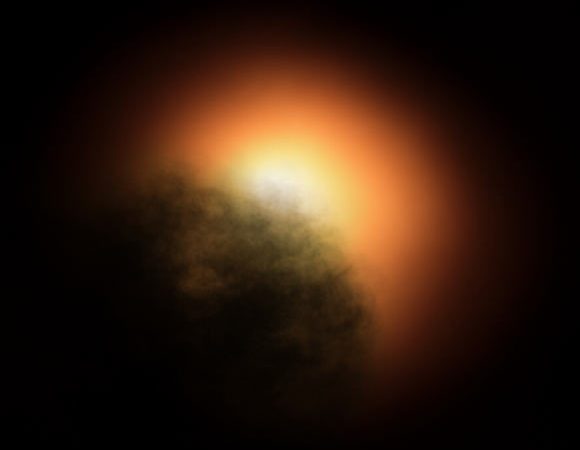The red supergiant Betelgeuse is one of the brightest stars in the night sky and appears even more luminous because it is so close to Earth, only 650 light-years away. But the star also periodically changes in brightness, which was first noted in the 1830s by the British astronomer John Herschel. Betelgeuse experienced an unexpected dimming during December 2019 and the first quarter of 2020, reaching an historic minimum on February 7-13. This dimming has mystified astronomers, who scrambled to develop several theories for the abrupt change. Ultraviolet observations by the NASA/ESA Hubble Space Telescope suggest that the dimming was probably caused by an immense amount of superhot material ejected into space. The material cooled and formed a dust cloud that blocked the starlight coming from about a quarter of Betelgeuse’s surface.
Source: Sci News
“With Hubble, we see the material as it left the star’s visible surface and moved out through the atmosphere, before the dust formed that caused the star appear to dim,” said Dr. Andrea Dupree, an astronomer at the Harvard & Smithsonian Center for Astrophysics.
“We could see the effect of a dense, hot region in the southeast part of the star moving outward.”
“This material was two to four times more luminous than the star’s normal brightness. And then, about a month later, the southern hemisphere of Betelgeuse dimmed conspicuously as the star grew fainter.”
“We think it is possible that a dark cloud resulted from the outflow that Hubble detected. Only Hubble gives us this evidence of what led up to the dimming.”
Dr. Dupree and colleagues began using Hubble early last year to observe the red supergiant.
Their observations are part of a three-year Hubble study to monitor variations in the star’s outer atmosphere.
The telescope’s sensitivity to ultraviolet light allowed the astronomers to probe the layers above the star’s surface, which are so hot that they emit mostly in the ultraviolet region of the spectrum and are not seen in visible light.
These layers are heated partly by the star’s turbulent convection cells bubbling up to the surface.
“Spatially resolving a stellar surface is only possible in favorable cases and only with the best available equipment,” said Dr. Klaus Strassmeier, a researcher at the Leibniz Institute for Astrophysics Potsdam.
“In that respect, Betelgeuse and Hubble are made for each other.”

Hubble spectra, taken in early and late 2019 and in 2020, probed the star’s outer atmosphere by measuring spectral lines of ionized magnesium.
From September to November 2019, the researchers measured material passing from the star’s surface into its outer atmosphere.
This hot, dense material continued to travel beyond Betelgeuse’s visible surface, reaching millions of kilometers from the star. At that distance, the material cooled down enough to form dust.
This interpretation is consistent with Hubble ultraviolet-light observations in February 2020, which showed that the behavior of the star’s outer atmosphere returned to normal, even though in visible light it was still dimming.
“Although we don’t know the cause of the outburst, we thinks it was aided by the star’s pulsation cycle, which continued normally though the event, as recorded by visible-light observations,” Dr. Dupree said.
The team also used an automated telescope called STELLar Activity (STELLA) to measure changes in the velocity of the gas on the star’s surface as it rose and fell during the pulsation cycle.
“STELLA was designed for observing individual objects over a very long period of time — especially magnetically active stars,” Dr. Strassmeier said.
“It is perfectly suited for monitoring bright stars like Betelgeuse.”
“STELLA had and is observing it basically every clear night since 2006.”
Betelgeuse was expanding in its cycle at the same time as the convective cell was upwelling.
The pulsation rippling outward from Betelgeuse may have helped propel the outflowing plasma through the atmosphere.
“We will get another chance to observe the star with Hubble in August or early September,” the scientists said.
“Right now, Betelgeuse is in the daytime sky, too close to the Sun for Hubble observations.”
A paper on the findings was published online today in the Astrophysical Journal.
Source: Sci News

































Leave a Comment
You must be logged in to post a comment.